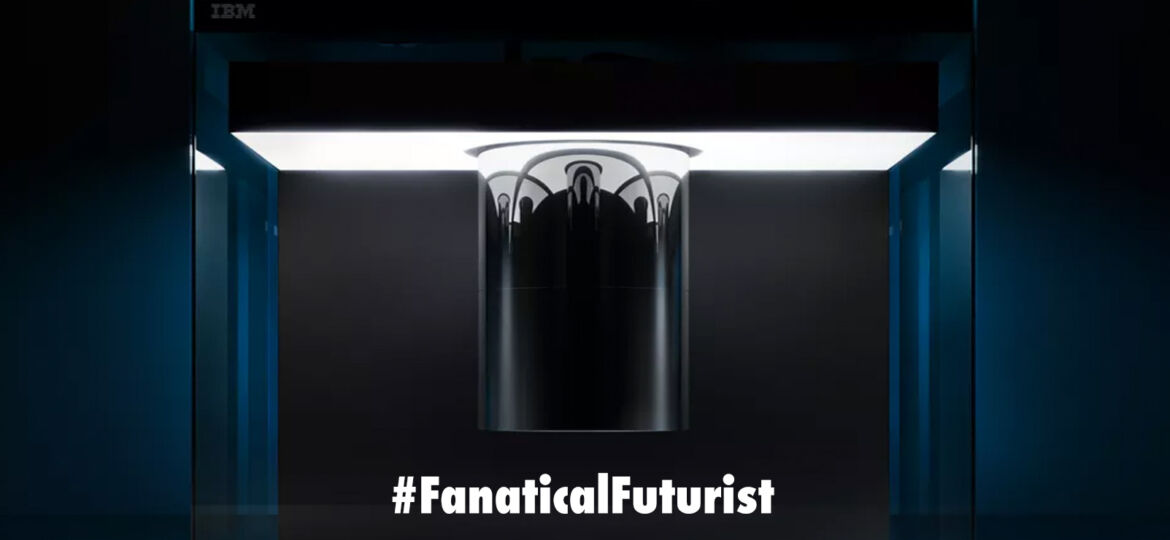
WHY THIS MATTERS IN BRIEF
As the race to be the first company in the world to build a viable, commercial quantum computer heats up IBM moves into prime position.
In the gruelling race to build a practical quantum computer, tech companies are keeping their spirits up by loudly cheering every milestone — no matter how small. One of the most vocal competitors is IBM, which today at CES unveiled the IBM Q System One – a 20 qubit quantum computer that’s built for stability, but with some very flashy design.
IBM is touting the Q System One as “the world’s first fully integrated universal quantum computing system designed for scientific and commercial use.” But that’s a description that needs a lot of context. The Q System One may be designed for commercial use, but it’s not exactly ready for it. Not in the way you might think.
Quantum computers like the Q System One are still very much experimental devices. They can’t outperform classical computers at useful tasks, in fact, your laptop is probably more powerful when it comes to real-life computation, but are instead supposed to be research tools; letting us work out, qubit by qubit, how quantum devices might work at all.
“It’s more like a stepping stone than a practical quantum computer,” says Winfried Hensinger, professor of quantum technologies at the UK’s University of Sussex who were the first to publish what is now regarded as a the world’s first quantum computer architecture, “Don’t think of this as a quantum computer that can solve all of the problems quantum computing is known for. Think of it as a prototype machine that allows you to test and further develop some of the programming that might be useful in the future.”
And even as an experimental device, it’s not like IBM is going to start selling the Q System One at Best Buy. The company won’t say how much it costs to buy one of these machines or even how many it’s made. Like IBM’s other quantum computers, it’s accessible only via the cloud, where companies and research institutes can buy time on the IBM Q Network. And today IBM announced two new customers on the network – energy giant ExxonMobil, and European research lab CERN, the organisation that built the Large Hadron Collider.
So what’s special about the Q System One? Well, IBM says the main achievement is turning an experimental quantum machine into something with reliability, and looks, closer to that of a mainframe computer. Quantum computing is an extremely delicate business. Chips need to be kept at freezing temperatures and can be disturbed by the tiniest electrical fluctuations or physical vibrations. The Q System One, says IBM, minimises these problems.
“This is something IBM brings to the market that no one else really does. We know how to do integrated systems,” says IBM’s VP of quantum research, Bob Sutor. “The electronics for a quantum computer are not something you go buy off the shelf. You need a temperature controlled environment, you need to minimise the vibrations — anything that might disrupt the quantum calculations.”
Sutor says that a practical advantage of engineering a machine like the Q System One is that it reduces research downtime. Resetting a quantum computer after an upset caused by a power surge or a disgruntled look from a technician is much, much quicker with a device like the Q System One.
“What used to take days and weeks now takes hour or days,” says Sutor. And while these might sound like marginal gains, if we’re ever going to have quantum computers that do change the world in all the ways we dream of, by discovering new drugs, for example, and unlocking fusion energy, reliable research will absolutely be key. And perhaps just as importantly, the Q System One looks the part.
The machine was designed by Map Project Office, an industrial design consultancy that’s worked with companies like Sonos, Honda, and Graphcore who I’ve discussed before because of their breakthrough Intelligence Processing Unit chip which was hailed by the founder of ARM as “the future of AI learning.” The Q System One is contained in a nine-foot borosilicate glass cube, with its delicate internals sheathed by a shiny, rounded black case it looks like a computer from the future.
For IBM this is not simply a side benefit — it’s part of the plan. The 107 year old company may still rake in billions in revenue each quarter, mostly from legacy enterprise deals, but it’s facing what some analysts have called “irreversible structural decline.” It’s failed to come out ahead in the tech industry’s most recent growth areas, mobile and cloud computing, and it needs new revenue streams to carry it through its second century of existence. Artificial Intelligence (AI) is one bet, and quantum computing another.
Sutor doesn’t mention these problems, but he does note that the Q System One is supposed to inspire confidence — both in quantum computing and in IBM itself.
“People, when they see quantum computing systems, their eyes just glow,” he says. “And it’s because they understand that these things that were just rumoured about, or that were just too futuristic, are now starting to be produced. They can look at these things and say, ‘Ah, IBM sees the path forward!’”
Machines like the Q System One though are still useful on these terms, giving people a glimpse of the future, “but lest we need to be reminded,” says Hensinger, “there’s lots of work yet to be done.”
“I wouldn’t call this a breakthrough,” he says. “But it’s a productive step towards commercial realisation of quantum computing.”
















